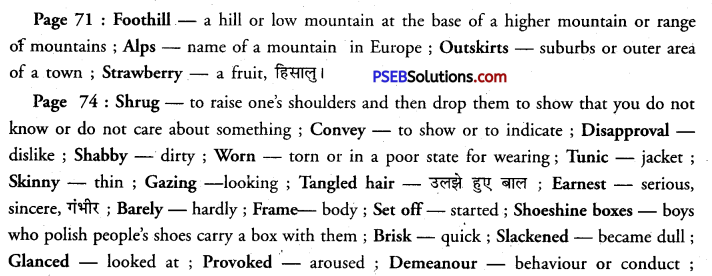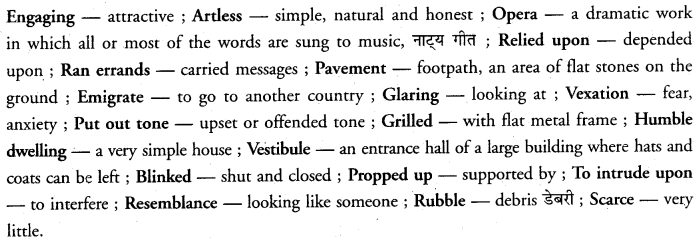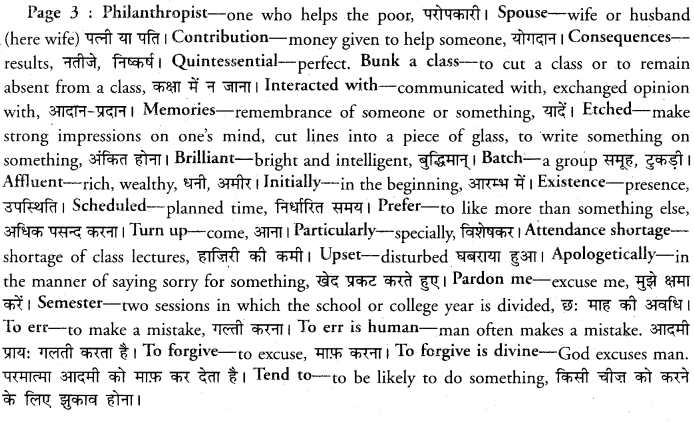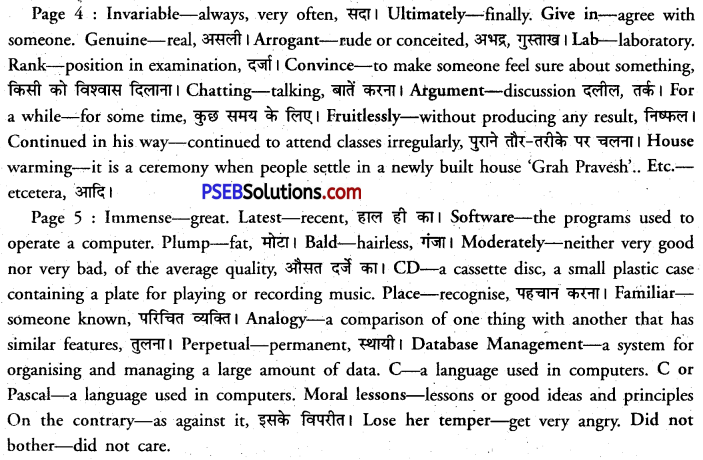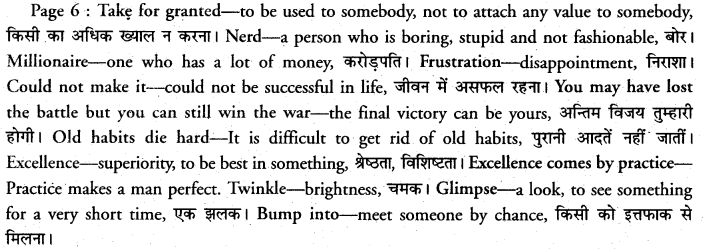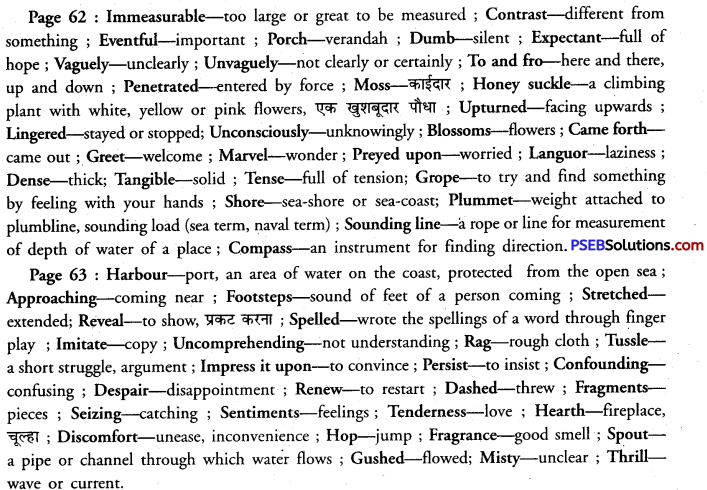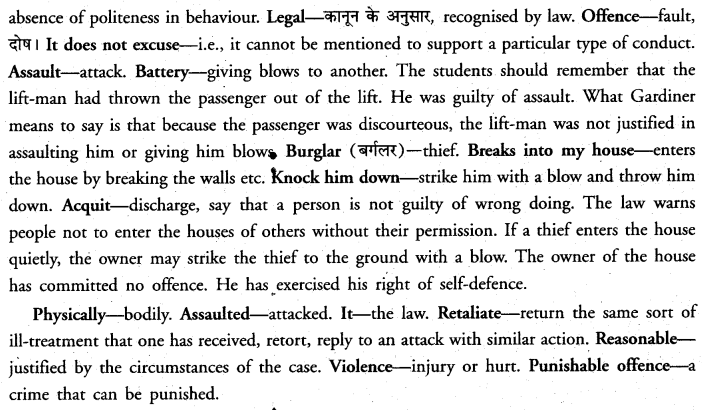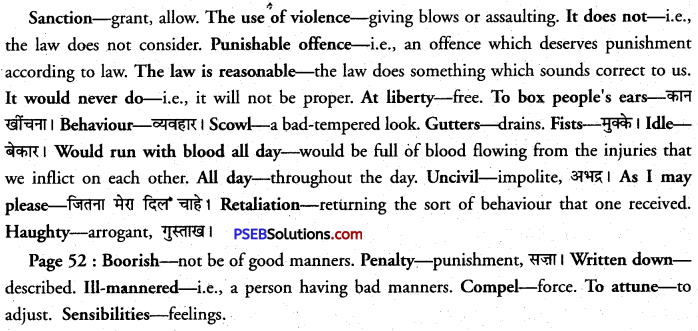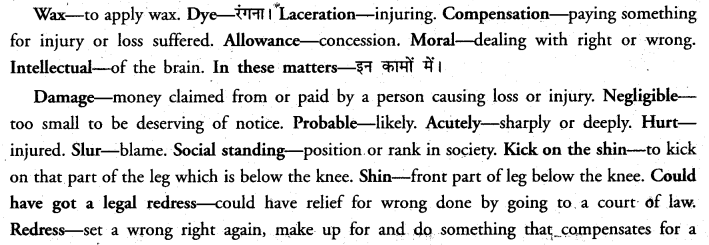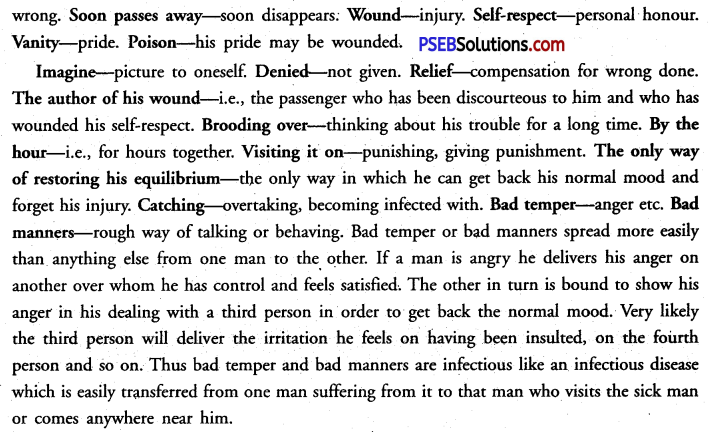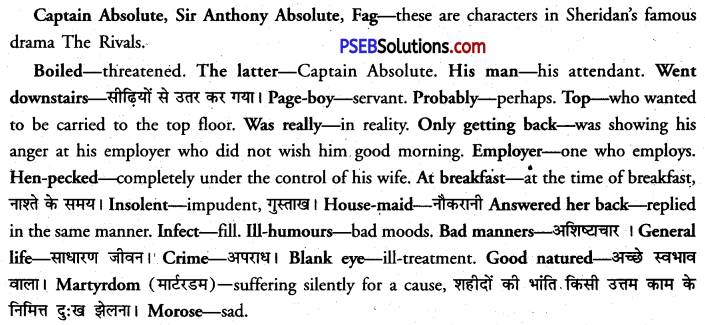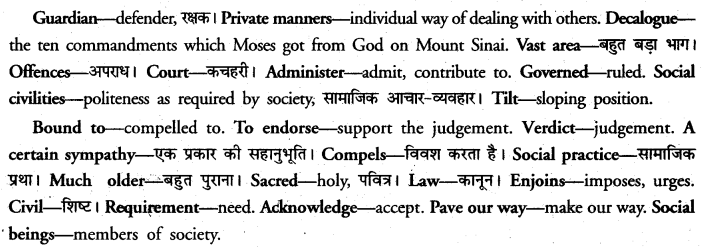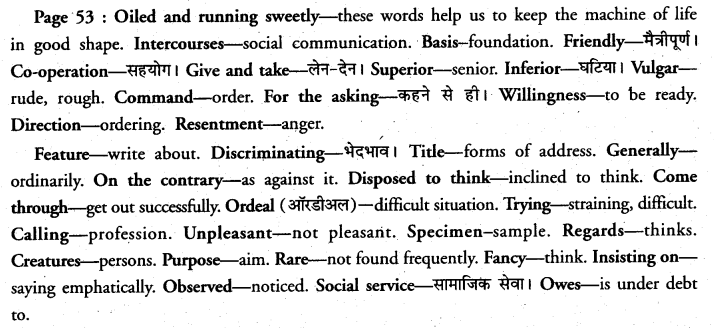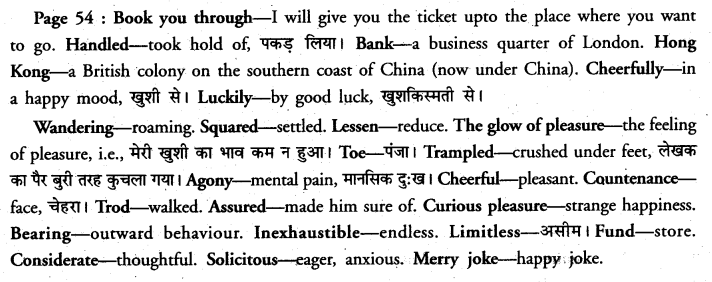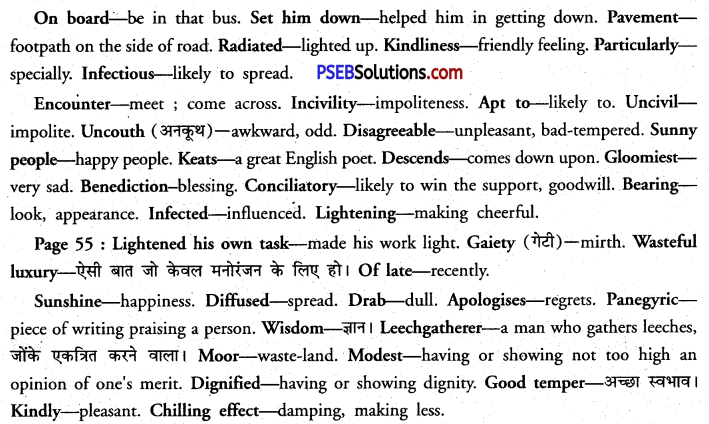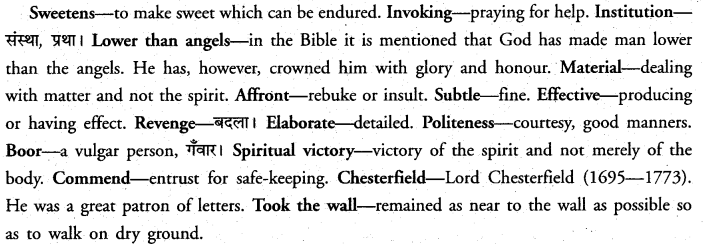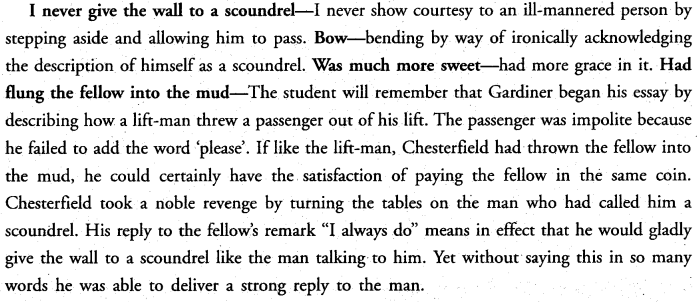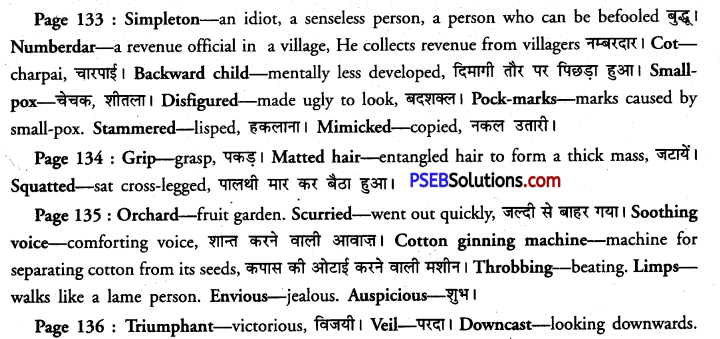Punjab State Board PSEB 12th Class English Book Solutions Supplementary Chapter 5 The Barber’s Trade Union Textbook Exercise Questions and Answers.
Class 12th English Supplementary Chapter 5 The Barber’s Trade Union Question Answers
The Barber’s Trade Union Class 12 Questions and Answers
Short Answer Type Questions
Question 1.
How did the village elders behave when Chandu dressed up like a doctor?
गांव के वयोवृद्धों ने कैसा व्यवहार किया जब Chandu डाक्टरों की तरह कपड़े पहन कर आया ?
Answer:
The landlord called Chandu the son of a pig. He cursed him by saying that he was bringing a leather bag of cow-hide into his house and a coat of some animal’s marrow. He told him to get out of his house less he should defile his religion.

The Sahukar abused Chandu in the foulest way. He told him that he had come wearing the defiled clothes of the hospital people. He told him to come after wearing his own clothes. Only then will he let him cut his hair.
जमींदार ने उसको सूअर का पुत्र कह कर पुकारा। उसने उसे यह कहकर गाली दी कि वह उसके घर में चमड़े का बैग लेकर आया जोकि गाय की चमड़ी का बना है और उसने कोट पहना है जो किसी पशु के मज्जे से बना है। उसने उसको आदेश दिया कि वह उसके घर से निकल जाये ताकि वह उसके धर्म को भ्रष्ट न कर दे। साहूकार ने भी बड़े गन्दे शब्दों में Chandu को गालियां दीं। उसने उसको कहा कि वह हस्पताल के लोगों के गन्दे कपड़े पहन कर आ गया था। उसने उसे कहा कि वह अपने कपड़े पहन कर आये। तभी वह उससे अपने बाल कटवायेगा।
Question 2.
Give a brief character-sketch of Chandu’s mother.
Chandu की माता का संक्षेप में चरित्र-चित्रण दीजिए।
Answer:
Chandu’s mother was an ill-tempered woman. She was over sixty years old. She could always read the nature of the upper caste people. But she was very kind to the narrator. She did not have a good word for the upper caste people.
Probably, she must have suffered at the hands of the upper caste people. She was happy when Chandu started earning more money by shaving and cutting hair of people in the town. We can only pity Chandu’s old mother because she did not have a good quality of life.
Chandu की माता चिड़चिड़े स्वभाव की महिला थी। वह साठ साल से ऊपर उम्र की थी। वह उच्चजाति के लोगों के स्वभाव को जान लेने में सक्षम थी। लेकिन वह वर्णनकर्ता पर बहुत मेहरबान थी। उसका ऊँची जाति के लोगों के बारे में कोई अच्छा विचार नहीं था। सम्भवतः उसने ऊँची जाति के लोगों से कष्ट उठाये हैं। वह खुश थी जब चन्दू ने शहर में जाकर लोगों की दाढ़ी और हजामत करके अधिक पैसे कमाने शुरू कर दिये। हमें उसकी बूढ़ी माता पर दया आती है क्योंकि उसने अच्छे प्रकार का जीवन व्यतीत नहीं किया है।
Long Answer Type Questions
Question 1.
Give a brief character-sketch of Chandu.
Answer:
Chandu is the barber boy of the narrator’s village. He is the main character of the story. He is a close friend of the narrator. The narrator calls him one of the makers of modern India. He organises barbers into a union.
He stops going to people’s homes to give them a haircut or shave beards. He refuses to dance to the tune of upper-caste people. Chandu is the narrator’s senior. He takes lead in all matters. He is very fond of his boyish mischiefs.
He likes catching wasps. Then he takes out the poison from their tails. He makes them fly by tying their legs with a thread. The narrator considers him the embodiment of perfection. He is an expert at making kites of various designs. Despite his skill in other matters, he is a duffer in learning. He is a member of a low caste. Upper caste people often abused him and insulted him. They did not like the narrator to mix with him.

Chandu is self-respecting. He did not like to be insulted by the upper-caste people. He decided to teach them a lesson. He bought a cycle and started shaving people in the town. He set up a barber’s shop. He organised some barbers in villages into a union.
They stopped going to people’s homes for haircutting and shaving. They forced the people to come to their shops. We cannot help admiring Chandu for his skill of enterprise.
Chandu वर्णनकर्ता के गांव के नाई का लड़का है। वह कहानी का मुख्य पात्र है। वह वर्णनकर्ता का घनिष्ठ मित्र है। वर्णनकर्ता उसको आधुनिक भारत के निर्माताओं में से एक समझता है। वह नाईयों के Union का आयोजन करता है। वह लोगों के घरों में जाकर उनके लिए बतौर नाई का काम करने से इन्कार कर देता है। वह ऊँची जाति के लोगों के इशारों पर नाचने से मना कर देता है। Chandu वर्णनकर्ता से वरिष्ठ है। वह तमाम मामलों में अगवाई करता है। वह लड़कों वाली शरारतें करता है।
वह भिड़ों को पकड़ना पसन्द करता है। फिर वह उनका विष निकालता है। उनकी टांगों को धागे से बांध कर उनको उड़ता है। वर्णनकर्ता Chandu को पूर्णता का साकार समझता है। वह कई designs वाले पतंग बनाने में बहुत निपुण है। दूसरे मामलों में प्रवीणता के बावजूद, वह पढ़ाई में निकम्मा है। वह निचली जाति का सदस्य है। ऊँची जाति के लोग उसको प्रायः गालियां देते थे और अपमानित करते थे। वे नहीं चाहते थे कि वर्णनकर्ता उससे मेलजोल रखे।
Chandu स्वाभिमानी है। वह नहीं चाहता कि ऊँची जाति के लोग उसका अपमान करें। उसने उनको सबक सिखाने का निर्णय कर लिया। उसने भिन्न गांवों के कुछ नाईयों का Union स्थापित कर लिया। उसने एक साइकिल खरीद लिया और इस पर सवार होकर अपना नाई का काम करने लगा। उसने नाई की दुकान खोल ली। नाईयों ने लोगों के घरों में हजामत और शेव आदि के लिए जाना बन्द कर दिया। हम उसकी उद्यमशीलता के लिए Chandu की प्रशंसा किए बिना नहीं रह सकते।
Question 2.
Why did Chandu go on a strike ? What was the result of the strike ?
Chandu ने हड़ताल क्यों की ? हड़ताल का क्या नतीजा निकला ?
Answer:
Chandu was a barber in a village. He used to go to people’s homes to cut their hair and shave their beards. He started going to the town from time to time. He earned more money there by haircutting. One day he put on a doctor’s dress and went on the round of his village to shave the beards of a landlord, a sahukar and some other person. They were all from higher castes. But Chandu belonged to a lower caste.
The narrator and the landlord’s little boy Devi were happy to see him in the doctor’s dress. The landlord called him the son of a pig. He insulted him by saying that he was carrying a leather bag of cow-hide and the coat of the marrow of some animal.
He told him to get out of his house. He did not want his house and his religion to be defiled. He asked him to wear the clothes that suit his profession. Then he went to the village Shaukar’s house. He abused Chandu in the foulest way.
He told him not to go about dressed like a clown. He should shoulder his own responsibilities and look after his old mother. He should not wear the defiled clothes of the hospital folk. He told him to go and come back in his own clothes.

Then he would let him cut his hair. He decided to teach the orthodox village idiots a lesson. He would go on strike and not go to their houses to attend to them. They were forced to go to his shop to get their beards shaved and their hair cut.
Chandu गांव का नाई था। वह लोगों के घरों में जाकर उनके बाल काटता था और दाढ़ियां साफ़ किया करता था। उसने कभी-कभी शहर जाना भी शुरू कर दिया। वहां वह हजामतों द्वारा अधिक पैसे कमा लेता था। एक दिन उसने डॉक्टर की dress पहन ली और उसने अपने गांव का चक्कर लगाना आरम्भ किया ताकि वह एक जमींदार, एक साहूकार और किसी और व्यक्ति की दाढ़ी की shave कर दे। वे सब ऊँची जाति के थे। परन्तु Chandu नीची जाति का था। वर्णनकर्ता और ज़मींदार का छोटा बच्चा उसको डॉक्टर के कपड़ों में देखकर बहुत खुश हुए। लेकिन जमींदार ने उसको सूअर का पुत्र कह कर पुकारा।
उसने यह कर उसका अपमान किया कि उसने गाय की त्वचा से बने बैग और किसी पशु के मजे का कोट पहना हुआ था। उसने उसको कहा कि वह उसके घर से बाहर निकल जाये। वह नहीं चाहता कि उसका घर और धर्म भ्रष्ट हो जायें। उसने उसको यह भी कहा कि वह कपड़े पहने जो उसके व्यवसाय के अनुसार उचित हो। इसके बाद वह गांव के साहूकार के घर गया। उसने चन्दू को बहुत ही गन्दी गालियां दीं।
उसने उसे कहा कि वह जोकर के कपड़े पहन कर न घूमे फिरे। उसे अपनी जिम्मेदारियां निभानी चाहिये और अपनी बूढी माता का ध्यान रखना चाहिए। उसे हस्पताल के लोगों के प्रदूषित कपड़े नहीं पहनने चाहिए। उसने उसे कहा कि वह जाये और अपने कपड़ों में वापस आये। तब वह उसके बाल काट सकेगा। उसने गांव के गांव के रुढ़िवादी मूल् को सबक सिखाने का निर्णय किया। वह हड़ताल करेगा और उनकी सेवा में उनके घरों में नहीं जायेगा। उन्हें विवश होकर Chandu की दुकान पर जाना पड़ा ताकि वे अपने बाल और दाढ़ियां कटवा सकें।
कि ऊँची जाति के लोग उसका अपमान करें। उसने उनको सबक सिखाने का निर्णय कर लिया। उसने भिन्न गांवों के कुछ नाईयों का Union स्थापित कर लिया। उसने एक साइकिल खरीद लिया और इस पर सवार होकर अपना नाई का काम करने लगा। उसने नाई की दुकान खोल ली। नाईयों ने लोगों के घरों में हजामत और शेव आदि के लिए जाना बन्द कर दिया। हम उसकी उद्यमशीलता के लिए Chandu की प्रशंसा किए बिना नहीं रह सकते।
Question 2.
Why did Chandu go on a strike ? What was the result of the strike ?
Chandu ने हड़ताल क्यों की ? हड़ताल का क्या नतीजा निकला ?
Answer:
Chandu was a barber in a village. He used to go to people’s homes to cut their hair and shave their beards. He started going to the town from time to time. He earned more money there by haircutting. One day he put on a doctor’s dress and went on the round of his village to shave the beards of a landlord, a sahukar and some other person. They were all from higher castes. But Chandu belonged to a lower caste.

The narrator and the landlord’s little boy Devi were happy to see him in the doctor’s dress. The landlord called him the son of a pig. He insulted him by saying that he was carrying a leather bag of cow-hide and the coat of the marrow of some animal.
He told him to get out of his house. He did not want his house and his religion to be defiled. He asked him to wear the clothes that suit his profession. Then he went to the village Shaukar’s house.
He abused Chandu in the foulest way. He told him not to go about dressed like a clown. He should shoulder his own responsibilities and look after his old mother. He should not wear the defiled clothes of the hospital folk. He told him to go and come back in his own clothes.
Then he would let him cut his hair. He decided to teach the orthodox village idiots a lesson. He would go on strike and not go to their houses to attend to them. They were forced to go to his shop to get their beards shaved and their hair cut.
Chandu गांव का नाई था। वह लोगों के घरों में जाकर उनके बाल काटता था और दाढ़ियां साफ़ किया करता था। उसने कभी-कभी शहर जाना भी शुरू कर दिया। वहां वह हजामतों द्वारा अधिक पैसे कमा लेता था। एक दिन उसने डॉक्टर की dress पहन ली और उसने अपने गांव का चक्कर लगाना आरम्भ किया ताकि वह एक जमींदार, एक साहूकार और किसी और व्यक्ति की दाढ़ी की shave कर दे। वे सब ऊँची जाति के थे।
परन्तु Chandu नीची जाति का था। वर्णनकर्ता और ज़मींदार का छोटा बच्चा उसको डॉक्टर के कपड़ों में देखकर बहुत खुश हुए। लेकिन जमींदार ने उसको सूअर का पुत्र कह कर पुकारा। उसने यह कर उसका अपमान किया कि उसने गाय की त्वचा से बने बैग और किसी पशु के मजे का कोट पहना हुआ था।
उसने उसको कहा कि वह उसके घर से बाहर निकल जाये। वह नहीं चाहता कि उसका घर और धर्म भ्रष्ट हो जायें। उसने उसको यह भी कहा कि वह कपड़े पहने जो उसके व्यवसाय के अनुसार उचित हो। इसके बाद वह गांव के साहूकार के घर गया। उसने चन्दू को बहुत ही गन्दी गालियां दीं।
उसने उसे कहा कि वह जोकर के कपड़े पहन कर न घूमे फिरे। उसे अपनी जिम्मेदारियां निभानी चाहिये और अपनी बूढी माता का ध्यान रखना चाहिए। उसे हस्पताल के लोगों के प्रदूषित कपड़े नहीं पहनने चाहिए। उसने उसे कहा कि वह जाये और अपने कपड़ों में वापस आये। तब वह उसके बाल काट सकेगा। उसने गांव के गांव के रुढ़िवादी मूल् को सबक सिखाने का निर्णय किया। वह हड़ताल करेगा और उनकी सेवा में उनके घरों में नहीं जायेगा। उन्हें विवश होकर Chandu की दुकान पर जाना पड़ा ताकि वे अपने बाल और दाढ़ियां कटवा सकें।

Objective Type Questions:
This question will consist of 3 objective type questions carrying one mark each. These objective questions will include questions to be answered in one word to one sentence or fill in the blank or true/false or multiple choice type questions.
Question 1.
What was the age difference between Chandu and the narrator ?
Answer:
It was a difference of six months; Chandu was senior to the narrator.
Question 2.
Why did the narrator consider Chandu the embodiment of perfection for him ?
Answer:
He considered him the embodiment of perfection because he could make and fly paper kites of complicated designs and balance which the narrator could not do.
Question 3.
Why was Chandu not good at doing sums at school ?
Answer:
He was not good at doing sums because he did not do any homework given by teachers and he went to learn the work as a barber.
Question 4.
Why did the narrator’s mother constantly dissuade him to play with Chandu ?
Answer:
She dissuaded him by saying that Chandu was a low-caste barber’s son and he had to keep up the status of his caste and class.
Question 5.
What does the narrator tell us about Chandu’s dress?
Answer:
Chandu wore a Khaki shorts, black velvet waist-coat with many buttons and a round felt cap.
Question 6.
What did Chandu tell the narrator about Kalan Khan’s appearance ?
Answer:
He was a young man with parted hair, dressed in a starched shirt, an ivory collar and bow tie, a black coat and striped trousers and a wonderful rubber overcoat.
Question 7.
Why did Bijay Chand, the landlord, turn Chandu out of his house ?
Answer:
He told him to get out of his house as he was defiling it with a leather bag of cow hide, a coat of some animal’s marrow and to wear the dress suiting his profession.
Question 8.
What did the Sahukar think about Chandu’s wearing clothes like a doctor ?
Answer:
He abused him and told him to come back in his own clothes and not wear the defiled clothes of the hospital people.
Question 9.
Why had the landlord summoned Pandit Parmanand ?
Answer:
He had been called by the landlord to discuss the unholy emergency in which Chandu had landed by wearing English shoes and a doctor’s dress.
Question 10.
What type of woman was Chandu’s mother ?
Answer:
She was an ill-tempered woman from low caste and knew the reality about upper caste people.
Question 11.
How did Chandu’s mother treat the narrator ?
Answer:
She was very kind to the narrator though she spoke to him in a joking manner.

Question 12.
Why did Chandu decide to go on strike ?
Answer:
He decided to go on strike by stopping to shave the upper-caste people as they had been abusing him.
Question 13.
Why did Chandu decide to buy a bicycle ?
Answer:
He decided to buy a cycle in order to shave people and give them a haircut and earn money after stopping to do the haircut of the upper-caste people.
Question 14.
Why had the men gathered in the Sahukar’s shop ?
Answer:
They had gathered there round the figure of the landlord to talk with him.
Question 15.
How did the Sahukar look without being trimmed by the barber?
Answer:
He looked like a leper with the brown colour of tobacco on his big moustaches.
Question 16.
What jokes became popular in every home and why?
Answer:
Jokes about the unclean beards of the elders and the landlord’s young wife threatening to run away with somebody because of his shabby appearance became popular.
Question 17.
What was the reason of the rumour that the landlord’s wife had threatened to run away with someone else ?
Answer:
She threatened to do so because being twenty years younger than her husband, she had tolerated him as long as he kept in trim. But now his unclean beard was disgusting to her.
Question 18.
What did the village elders threaten Chandu ?
Answer:
They threatened to have him sent to prison for his offences and ordered his mother to force him to obey them.
Question 19.
Name the union that gave birth to many other active trade unions in the town.
Answer:
The name was ‘Rajkot District Barber Brothers’ Hairdressing and Shaving Saloon’.
Question 20.
Was the narrator of the story caste conscious ?
Answer:
No.

Question 21.
Did the narrator’s mother like him to play with Chandu ?
Answer:
No.
Question 22.
Who was Kala Khan ?
Answer:
Dentist.
Question 23.
Who abused Chandu ?
Answer:
The Sahukar.
Question 24.
What was the name of the landlord’s son ?
Answer:
Devi.
Question 25.
What was the opinion of Chandu’s mother about the high caste people ?
Answer:
They were hypocrites.
Question 26.
What was Chandu going to buy with five rupees ?
Answer:
A Japanese cycle.
Question 27.
The landlord’s wife threatead to run away unless :
(i) he gave her all his money.
(ii) he stopped staying away from home.
(iii) he looked smart, trim and handsome.
Answer:
(iii) he looked smart, trim and handsome.
Question 28.
Who was younger of the landlord and his wife ?
Answer:
His wife.
Question 29.
The landlord’s wife wanted to run away with someone smarter and trim. (True/False)
Answer:
True.
Question 30.
What was Chandu in Barbers’ Trade Union ?
Answer:
He was a barber boy.
The Barber’s Trade Union Summary in English
The Barber’s Trade Union Introduction:
This is the story of a barber boy. He is the main character in the story. The author calls him one of the makers of modern India. He does a great act. He unites the barbers and asks them to open their own barber shops and not to go to people’s homes to give them a haircut or shave. Thus the upper-caste people are compelled to go to the shops for hair-cut or a shave. The barber boy is senior to the narrator.
He is also the narrator’s close friend. He takes the lead in all the matters. He is very fond of boyish mischiefs. He likes catching wasps. Then he takes the poison out of their tails and makes them fly by tying their legs with a thread. He knows how to make very good kites of various designs. Despite these talents he is very dull at school. Chandu adopted the profession of his father.
As he belonged to a low caste, people of higher castes made fun of him. In the end he decided to go on strike and stopped visiting people’s houses for giving a hair-cut or shave. The people of the village had to go to barbers’ shops for hair-cuts. Then he becomes the organiser of Barbers’ Union.
The Barber’s Trade Union Summary in English:
Chandu is the barber boy of the narrator’s village. He has a place in the history of India as one of the makers of modern India. He has done something which has great significance. But he never had any idea about his greatness. The narrator knows him since his childhood. They used to play together in the streets of their village near Amritsar. Their mothers felt happy to see them at play.
Chandu was the narrator’s senior by six months. He always took the lead in all matters. The narrator always followed him because he was an expert at catching wasps, taking the poison out of their tails, tying their tails with a thread and making them fly. But the narrator used to be stung on his cheeks if he went near the wasp.

The narrator considered Chandu to be perfect because he could make and fly kites of very good designs. At school, Chandu was not so good at doing sums as the narrator because his father put him in learning the trade of a barber. His father used to send him to villages for hair-cutting. He had no time for doing home work. But he was good at reciting poetry. He remembered all the verses in the textbook.
The narrator’s mother did not feel happy when Chandu won a scholarship at school while the narrator had to pay fees to be taught. She constantly told the narrator not to play with Chandu by saying that he was a low-caste boy and he must keep up the status of caste and class. The narrator had no sense of superiority of his class or caste.
His mother used to put a red caste-mark on his forehead every morning and he put on uchkin, the tight trousers, the gold worked shoes and the silk turban. He wanted to wear clothes like Chandu. Chandu used to wear a pair of khakhi shorts which the retired subedar had given him, a black velvet waist-coat and a round cap which had once belonged to Lala Hukam Chand, the lawyer of their village.
The narrator envied Chandu the freedom of movement which he enjoyed after the death of his father. He used to go to the houses of upper caste people and cut their hair or shave them. When Lala Hukam Chand went to town in his carriage (buggy), Chandu went with him by sitting on the foot-rest of the buggy. The narrator had to walk three miles to attend his school at Jandiala. Chandu did not have to go to school. But he used to bring some gifts for the narrator.
Chandu saw sahibs, the lawyers, the chaprasis and the policemen wearing English style clothes. Once he told the narrator that he wanted to steal some money from home to buy a dress like that of Kalan Khan, the dentist. He said that Kalan Khan was fitting people with dentures and even new eyes. Kalan Khan was a young man. He was dressed in a starched shirt, an ivory collar and bow tie. He wore a blank coat and striped trousers and rubber overcoat and pumps.
Then he asked the narrator if he, a barber educated up to the fifth class, would not look more dignified by wearing a dress like Dr. Kalan Khan. Chandu added that though he was not a doctor, he has learnt how to treat pimples, boils and cuts on people’s bodies from his father who had learnt from his father.
The narrator agreed with his plan. He encouraged him a good deal that his hero did. One day Chandu dressed up in a turban, a white rubber coat, a pair of pumps with a leather bag in his hand. He was going on his round and had come to see the narrator. How smart he looked in his new dress. The narrator told him that he looked marvellous.
Then he left for the house of the landlord to shave every morning. The narrator followed Chandu. He looked nice in a doctor’s dress. He reached the door-step of the landlord. Devi, the little son of the landlord clapped his hands to announce the coming of Chandu the barber in a beautiful heroic dress like the Padre Sahib of the Mission School.

Bijay Chand, the stout landlord was taking the name of God. He was just coming out of the lavatory. He called Chandu the son of a pig. He regretted that Chandu was bringing a leather bag of cow-hide into his house, and the coat of the marrow of some animal, and black shoes. He ordered him to get out as he was defiling his house.
Chandu told him that he was wearing the dress of a doctor. He ordered him to wear clothes suiting his status as a barber. Chandu returned. His face was flushed as he had been insulted before the narrator. Then he rushed to the shop of Thanu Ram, the village Sahukar. He had a grocer’s store at the corner of the lane.
When the narrator reached Sahukar’s shop. Devi, the landlord’s son began to cry at his father’s harsh words for Chandu. He abused Chandu in the foulest words for wearing the dirty clothes of the hospital folk. He told him to come back in his own clothes. Then only he will let him cut his hair.
Chandu felt very angry. He ran angrily past the narrator. He felt that Chandu hated him because he belonged to a superior caste. The narrator shouted after Chandu that he should go to Pandit Parmanand and tell him that the clothes were not dirty.
Pandit Parmanand came out of the landlord’s house. He said that the boys of the village had been spoiled by education. But the low caste boy has no right to such clothes. He has to touch the heads and beards of people in the village. He should not defile them. Chandu heard what was said by Parmanand. He ran away from there. He seemed to have some set purpose in mind.
The narrator’s mother called him and told him that it was time for him to go to school. So he should eat and go to school. She advised him not to mix with the barber boy. But the narrator was very disturbed about Chandu’s fate all day. On his way back from school, he called in at the hut where Chandu lived with his mother. His mother was an ill-tempered woman.
As a low caste-woman she could understand the upper caste people. She however liked the narrator. She asked him if he had come to see his friend. She also told him that if his mother came to know that he had come to this hut, she would accuse her for casting her evil eyes on his sweet face. She asked him if he was as innocent as he looked or if he was a hypocrite like the rest of others of his caste.
The narrator wanted to know where Chandu was. She did not know where he was. She said that he earned some money by shaving people on the roadside. She also said that he was having some funny ideas. She added that he should serve the clients his father used to serve. He is only a boy. She told the narrator that she will tell him that his friend wanted to play with him. He has just gone up the road. The narrator took leave of Chandu’s mother.
Chandu whistled for the narrator in the afternoon. He came. He invited the narrator to come for a walk. He told him that he earned a rupee shaving and hair cutting near the court that morning as he had to come back on the back bar of Hukam Chand’s carriage early. In the afternoon, he should have earned more.
He told the narrator that he was going to teach a lesson to the caste conscious idiots. He was going on strike. He will not go to their houses to attend to them. He was going to buy a Japanese bicycle for five rupees. He shall learn to ride it.
Then he will go to town every day. He will ride the bicycle with his overcoat, his black shoes, and white turban on his head. He will look fine in this dress. The narrator said that he would definitely look nice.

The narrator supported Chandu’s ideas. Chandu bought a cycle with the money le had made by haircuts and shaving in the town. Then one day he started learning how to cycle. Chandu got on the cycle and the narrator started pushing him from the backside. Chandu could not keep balance and he fell down on the other side along with the cycle.
There were peals of laughter from the shop of the Sahukar. Then the Sahukar abused Chandu for being a rascal. He said that he would come to his sense only if he broke his bones. Chandu hung his head in shame. He told the narrator that he was worthless. The narrator had thought that Chandu would grip him by the neck and give him a good beating.
Chandu did not lose courage. He decided to try riding cycle again. The narrator told Chandu that he would hold the cycle tightly this time. The landlord again said that Chandu would break his bones by falling from the cycle. Chandu however told the narrator that he was not bothered.
Chandu again began to try riding. The people at the Sahukar’s shop were watching with interest. The narrator thought that Chandu would again fall and come to greif. Chandu’s feet had got quite rightly on the pedals and he was riding smoothly. The narrator was running behind the cycle. The narrator did not see Chandu the next day.
For one or two days the narrator did not see Chandu. But on the third day, Chandu showed the narrator some men of the village sitting round the Sahukar. He showed him the unshaven faces of the villagers. They were all looking unclean.
Chandu told the narrator to run past the shop and call the elderly people beavers. The narrator did so. The peasants who had gathered round the shop laughed. The Sahukar shouted that the narrator should be caught. They said that the upper-caste boy was also with Chandu.
The rumour about the barber boy’s strike spread. Jokes about the dirty beards of the elders also spread. The landlord’s wife threatened to run away with someone because she was twenty years younger than her husband. She had tolerated him as long as he looked neat and trim. But now she was disgusted with him because his appearance had become shabby.
But Chandu’s mother was seeing prosperity because of Chandu’s increasing income. Then they thought of getting the barber of Verka to come and attend them. They offered him an anna instead of the two pice they had usually paid to Chandu. Chandu opened a new shop and he asked other barbers from other villages to come and start their shops.
He convinced them that it was time that the villagers came to them for hair-cut and shave. The Union of barbers was given a new name. The name was “Rajkot District Barber Brothers Hairdressing and Shaving Saloon”. The Union has been followed by many other trade unions of working men.
The Barber’s Trade Union Summary in Hindi
The Barber’s Trade Union Introduction:
यह एक नाई लड़के की कहानी है। वह इस कहानी में मुख्य पात्र है। लेखक उसको आधुनिक भारत के निर्माताओं में एक समझता है। वह एक महान कार्यकर्ता है। वह नाईयों को एक कर देता है और उनको कहता है कि वे अपनी-अपनी नाई की दुकान खोल लें और लोगों को घरों में उनके बाल काटने या शेव करने के लिए न जायें।
इस तरह ऊंची जाति के लोगों को विवश होकर नाई की दुकानों पर जाना पड़ता है। कहानी के मुख्य पात्र का नाम चन्दू है। वह वर्णनकर्ता का मित्र है। वह वर्णनकर्ता से बड़ा है। वह वर्णनकर्ता का घनिष्ट मित्र भी है। बड़ा होने के कारण Chandu हर मामले में अगवाई करता है। वह लड़कों वाली शरारतें करने का बहुत शौकीन है।
वह भिड़ों को पकड़ना पसन्द करता है। फिर वह उनकी दुमों से विष निकालता है और उनकी टांगों को धागे से बांध कर उड़ाता है। वह अच्छे नमूने के पंतग बनाना भी जानता है। इन योग्यताओं के बावजूद वह स्कूल में मन्दबुद्धि वाला छात्र है। वह जाति से नाई था। उसने अपने पिता का व्यवसाय अपना लिया।
चूंकि Chandu निचली जाति से सम्बन्ध रखता था, ऊंची जाति के लोग उसका अपमान किया करते थे। वे उसको गालियां भी दिया करते थे। अन्त में वह हड़ताल करने का निर्णय करता है और वह shave करने के लिए लोगों के घरों में जाना बन्द कर देता है। अब गांव के लोगों को हजामत करवाने के लिए उसकी दुकान में जाना पड़ता था।
The Barber’s Trade Union Summary in Hindi:
Chandu वर्णनकर्ता के गांव के नाई का लड़का है। उसका भारत के इतिहास में भारत के निर्माणकर्ताओं में से एक होने में उसका नाम है। उसने कुछ ऐसा काम किया है जिसका बड़ा महत्त्व है। लेकिन उसको अपनी महानता के बारें कोई विचार नहीं था। वर्णनकर्ता उसको अपने बचपन से जानता है।
Amritsar के समीप स्थित अपने गांव की गलियों में वे खेला करते थे। उनकी माताएं उनको खेलते हुए देखकर प्रसन्न हुआ करती थीं। Chandu वर्णनकर्ता से छः महीने बड़ा था। वह सब मामलों में अगवाई करता था। वर्णनकर्ता सदा उसका अनुसरण करता था क्योंकि वह भिड़ों (तातैया) को पकड़ने में निपुण था। वह उनकी दुमों से विष निकालता था और उनकी टांगों में धागा बांधता था और उनको उड़ाया करता था। लेकिन यदि वर्णनकर्ता भिड़ों के पास जाता तो वे उसकी गालों पर डंक मारती थीं।
वर्णनकर्ता Chandu को हर पक्ष में निपुण समझता था क्योंकि वह बहुत से नमूने के पतंग बना सकता था और उनको उड़ा भी सकता था। स्कूल में चन्दू गणित के प्रश्न हल करने में इतना अच्छा नहीं था क्योंकि उसके पिता ने उसको नाई का काम सीखने में डाल दिया था। उसका पिता उसको गांव में लोगों के बाल काटने के लिए भेजा करता था। Chandu के पास स्कूल से दिया हुआ homework करने के लिए समय नहीं था।
लेकिन वह कविता पाठ में अच्छा था। पाठ्य पुस्तकों की सब कविताएं उसे स्मरण थीं। – वर्णनकर्ता की माता खुश नहीं थी जब Chandu को स्कूल में छात्रवृत्ति मिली, जब कि वर्णनकर्ता को अपनी पढ़ाई के लिए फीस देनी पड़ती थी। वह लगातार वर्णनकर्ता को कहती थी कि वह चन्दू के साथ न खेला करे यह कहते हुए कि वह निचली जाति का लड़का था और उसे अपनी जाति और श्रेणी की प्रतिष्ठा बनाकर रखनी चाहिए। वर्णनकर्ता में अपनी श्रेणी या जाति की श्रेष्ठता के बारे कोई विचार तक नहीं था।
उसकी माता उसके माथे पर लाल रंग का तिलक लगाया करती थी और वह अचकन, चूड़ीदार पाजामा, तिल्ले वाले जूते और रेशमी पगड़ी पहना करता था। वह चन्दू जैसे कपड़े पहनना चाहता था। चन्दू खाकी निक्कर पहना करता था जो रिटायर्ड (retired) सूबेदार ने उसे दी थी और काली मखमल की बास्कट पहनता था। और साथ ही felt cap पहनता था जो कि लाला हुक्म चन्द ने उसे दी थी।

वर्णनकर्ता Chandu से ईर्ष्या करता था क्योंकि उसको घूमने फिरने की आज़ादी थी जो उसको अपने बाप की मौत के बाद उपलब्ध थी। वह ऊंची जाति के लोगों के घरों में जाया करता था और बाल काटा करता था या उनकी Shave किया करता था। जब Chandu Lala Hukam Chand की बग्गी में शहर जाया करता था तो बग्गी के पायदान पर बैठ जाता था। वर्णनकर्ता को Jandiala के स्कूल में जाने के लिए तीन मील चलना
पड़ता था। अब Chandu को स्कूल नहीं जाना पड़ता था। लेकिन वह वर्णनकर्ता के लिए कुछ उपहार लेकर आया करता था। Chandu साहिबों, वकीलों, चपरासियों और पुलिस वाले को देखा करता था जिन्होंने अंग्रेज़ी शैली के कपड़े पहने होते थे। एक बार चन्दू ने वर्णनकर्ता को बताया कि वह अपने घर से कुछ पैसे चुराकर दांतों के डाक्टर कालन खान की तरह एक dress खरीद लेगा।
वह कहता कि कालन खान लोगों के नये दांत लगाता था और नई आंखें भी लगाता था। वह स्टारच (कलफ वाली) लगी कमीज़ पहनता था, एक हाथी दांत का कालर और एक Bow tie भी पहनता था। वह एक काला कोट भी पहनता था और लकीरदार पतलून पहनता था और रबड़ का overcoat पहनता था और चमड़े के पम्पशू (गुरगाबी) पहनता था।
फिर वह वर्णनकर्ता से पूछता क्या वह पांचवी श्रेणी पढ़ा हुआ डॉक्टर कालन खान जैसे कपड़े पहनकर रोबदार और सम्मानित दिखेगा। चन्दू कहता गया कि यद्यपि वह डाक्टर नहीं भी है फिर भी उसने pimples (मुहांसो), फुसियों और काटे जाने के कारण घावों का इलाज करना सीखा हुआ है।
उसने यह सब अपने बाप से सीखा है। वर्णनकर्ता चन्दू की स्कीम से सहमत हो गया। उसका नायक (hero) जो कुछ भी करता था वर्णनकर्ता उसकी बहुत प्रशंसा करता था। एक दिन चन्दू ने Dr. Kalan Khan जैसे कपड़े पहन लिए, पगड़ी भी पहन ली, एक सफेद रबड़ का कोट पहन लिया, पम्पशू भी पहने और अपने हाथ में चमड़े का बैग ले लिया। वह लोगों की Shave आदि करने के लिए अपने दौरे पर जा रहा था।
और वह वर्णनकर्ता को मिलने आया था। वर्णनकर्ता ने उसे कहा कि वह कमाल का लगता है। फिर वह जमींदार के घर की ओर चल दिया ताकि वह उसकी हजामत करे। वर्णनकर्ता भी उसके पीछे चल दिया। वह (चन्दू) जमींदार के घर की दहलीज तक पहुंचा। चन्दू डाक्टर की dress में बहुत अच्छा लगता था। जमींदार के लड़के देवी ने चन्दू की शानदार वेशभूषा देखकर तालिया बजाईं। उसके अनुसार वह मिशन स्कूल के पादरी साहिब की तरह लगता था।
Bijay Chand जमींदार अभी शौचालय से बाहर आ रहा था। उसने Chandu को सूअर का बच्चा कह कर पुकारा। उसे दुःख था कि चन्दू गाय की त्वचा से बना हुआ चमड़े का बैग लिए जा रहा था और वह किसी जानवर के मजे का बना कोट पहने हुआ था और काले जूते। उसने चन्दू को कहा कि वह उसके घर से बाहर निकल जाये क्योंकि वह उसके घर को प्रदूषित कर रहा था। चन्दू ने कहा कि वह डाक्टर की dress पहने हुए था।
उसने उसे कहा कि वह नाईयों को ठीक लगने वाले कपड़े पहना करे। Chandu वहां से वापस चला गया। उसका चेहरा लाल हो गया था क्योंकि उसका वर्णनकर्ता के सामने अपमान हो गया था। फिर वह जल्दी-जल्दी गांव के साहूकार Thanu Ram की दुकान पर गया। उसकी किरयाने की दुकान गली के कोने में थी।
जब वर्णनकर्ता साहूकार की दुकान पर पहुंचा, जमींदार का लड़का देवी रोने लग पड़ा क्योंकि उसके बाप ने Chandu के लिए बड़े सख्त शब्द प्रयोग किए थे। उसने चन्दू को बहुत गन्दे शब्दों के प्रयोग से उसको गालियां दी क्योंकि उसके अनुसार चन्दू ने हस्पताल के लोगों के गन्दे कपड़े पहने थे। उसने उसे कहा कि वह अपने कपड़े पहन कर आये। तब ही वह उसको अपने बाल काटने देगा।
चन्दू को बहुत गुस्सा आया। वह वर्णनकर्ता के पास से निकल गया। उसने महसूस किया कि चन्दू उससे घृणा करता था क्योंकि वह ऊंची जाति से था। वर्णनकर्ता ने ऊंची आवाज़ में कहा कि वह पंडित परमानन्द के पास जाए और कहे कि कपड़े गन्दे नहीं थे। पंडित परमानन्द ज़मींदार के घर से बाहर आया।
उसने बाहर आकर कहा कि गांव के लड़कों को शिक्षा ने खराब कर दिया था लेकिन नीची जाति के लड़के को ऐसे कपड़े पहनने का कोई अधिकार नहीं था। उसने तो गांव के लोगों की दाढ़ियां और सिरों को हाथ लगाना है। उसे उनको प्रदूषित नहीं करना चाहिए। चन्दू ने वह सब जो परमानन्द ने कहा था सुन लिया। वह वहां से दौड़ गया। वर्णनकर्ता की माता ने उसको बुलाया और उसे कहा कि उसके स्कूल जाने का समय हो गया है। इस लिए उसे कुछ खाकर स्कूल जाना चाहिए।
उसने उसको कहा कि वह Chandu के साथ मेलजोल न रखे क्योंकि वह निचली जाति से सम्बन्ध रखता है। लेकिन वर्णनकर्ता को चन्दू की दशा के बारे में बहुत चिन्ता थी। स्कूल से वापस लौटते समय वह चन्दू की झोपड़ी में गया, जहां पर चन्दू अपनी माता के साथ रहता था। . उसकी माता बड़े चिड़चिड़े स्वभाव की थी। निचली जाति की होने के कारण वह ऊंची जाति के लोगों को अच्छी तरह से समझती थी।
फिर भी वह वर्णनकर्ता को पसन्द करती थी। उसने वर्णनकर्ता से पूछा क्या वह अपने मित्र को मिलने आया था। उसने उसे यह भी कहा कि यदि उसकी माता को पता लग गया कि वह इस झोपड़ी में आया था तो वह उसको दोष देगी कि वह उसके प्यारे चेहरे पर बुरी नज़र डालती है। उसने वर्णनकर्ता को पूछा कि क्या वह उतना ही मासूम है जितना वह दिखाई देता है या अपनी जाति के दूसरे लोगों की तरह बगुलाभक्त है।
वर्णनकर्ता जानना चाहता था कि चन्दू कहां है उसकी माता को नहीं पता था कि वह कहां है। उसने कहा कि चन्दू ने सड़क के पास बैठे हुए कुछ लोगों की Shave करके कुछ पैसे कमाये थे। उसने यह भी कहा कि Chandu के कुछ विचित्र विचार थे।
वर्णनकर्ता ने चन्दू के विचारों का समर्थन किया। Chandu ने कमाए हुए पैसों से साईकल खरीद लिया। उसने साईकल पर सवार होना भी सीखने की कोशिश की। Chandu cycle पर बैठ गया और वर्णनकर्ता ने पिछली तरफ से धकेलना शुरू कर दिया। चन्दू अपना सन्तुलन न रख सका और वह cycle से दूसरी साईड पर गिर गया और साथ ही उसका साईकल भी गिर गया।
साहूकार की दुकान से हंसी के ठहाके आने लगे। फिर साहूकार ने Chandu को गालियां दे कर कहा कि वह उल्लू का पट्ठा है। उसने फिर कहा कि उसके होश ठिकाने तब ही आयेंगे जब वह अपनी हड्डियां तोड़ लेगा। Chandu का सिर शर्म से झुक गया। उसने वर्णनकर्ता को कहा कि वह निकम्मा है।
वर्णनकर्ता ने सोचा कि Chandu उसको गर्दन से पकड़ लेगा और उसकी खूब पिटाई करेगा। Chandu ने हिम्मत नहीं हारी। उसने cycle पर फिर सवारी करने का फैसला कर लिया। वर्णनकर्ता ने चन्दू को कहा कि वह अब की बार साईकल को मज़बूती से पकड़ेगा। जमींदार ने कहा कि Chandu साईकल से गिरकर अपनी हड्डियां तोड़ लेगा। Chandu ने वर्णनकर्ता को कहा कि उसको कोई परवाह नहीं है।
Chandu ने फिर साईकल पर सवारी करने की कोशिश की। Sahukar की दुकान में बैठा जनसमूह बड़ी रुचि से देख रहा था। वर्णनकर्ता ने सोचा कि Chandu फिर से गिर जायेगा और उसको कष्ट होगा। Chandu के पांव अच्छी तरह पैडलों पर जम गए और वह आसानी से साईकल चलाता गया।
वर्णनकर्ता साईकल के पीछे भागता गया। अगले दिन वर्णनकर्ता Chandu को नहीं मिला। एक दो दिन वर्णनकर्ता Chandu से मिल नहीं सका। लेकिन तीसरे दिन Chandu ने वर्णनकर्ता को कुछ आदमी साहूकार के गिर्द बैठे हुए दिखाये। उसने वर्णनकर्ता को गांव वालों के चेहरे दिखाए जिनकी दाढ़ियां साफ-सुथरी नहीं थीं। वे सब गंदे नज़र आ रहे थे।
Chandu ने वर्णनकर्ता को कहा कि वह उस दुकान के पास दौड़ कर निकल जाये और वृद्धों को ऊदबिलाव कह कर पुकारे। वर्णनकर्ता ने वैसे ही किया। जो किसान दुकानों में बैठे थे वे हंसने लगे। Sahukar चिल्लाया कि वर्णनकर्ता को पकड़ना चाहिए। वे कहने लगे कि वह ऊंची जाति का लड़का था जो Chandu के साथ है।
नाई लड़के की हड़ताल के बारे अफवाह फैल गई। गंदी दाढ़ियों के बारे तरह-तरह के मज़ाक लोगों को सुनने में मिलने लगे। ज़मींदार की पत्नी ने धमकी दी कि वह किसी के साथ भाग जायेगी क्योंकि वह अपने पति से 20 साल कम आयु की थी। उसने तब तक उसको सहन किया था जब तक वह साफ-सुथरा था।

लेकिन अब उसको घृणा या विरक्ति हो गई थी क्योंकि उसकी शक्ल गंदी लगती थी। तब गांव वालों ने Verka से एक नाई लाने के बारे में सोचा। Chandu ने दुकान खोल ली। नाईयों का Union बना लिया गया। इस तरह उस ने गांव वालों को दुकानों पर आने पर विवश कर दिया। Barbers के Union को नया नाम दे गिया गया।
Word Meanings:
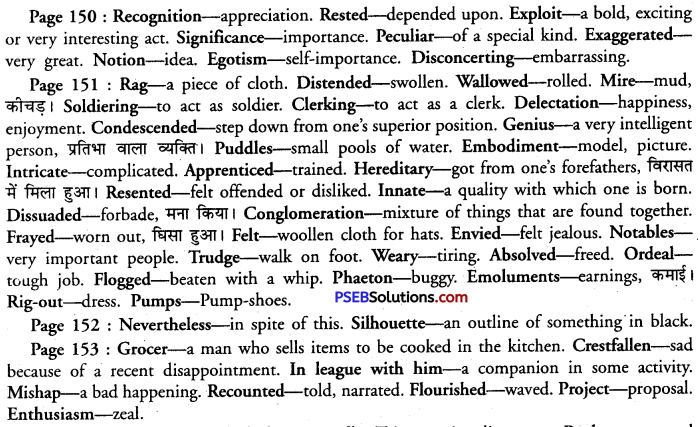
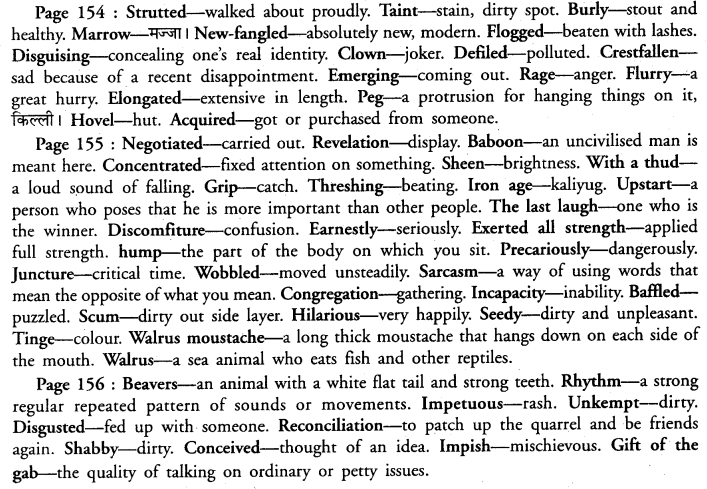
Class 12 PSEB Solutions Supplementary Reading
![]()
![]()
![]()
![]()
![]()
![]()
![]()
![]()
![]()
